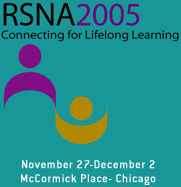
Abstract Archives of the RSNA, 2005
Riccardo Manfredi MD, Presenter: Nothing to Disclose
Rossella Graziani, Abstract Co-Author: Nothing to Disclose
Valeria Girardi, Abstract Co-Author: Nothing to Disclose
Calogero Cicero, Abstract Co-Author: Nothing to Disclose
Luca Frulloni, Abstract Co-Author: Nothing to Disclose
Roberto Pozzi Mucelli, Abstract Co-Author: Nothing to Disclose
To describe the CT features of autoimmune pancreatitis and the CT changes after treatment.
16 patients with autoimmune pancreatitis were retrospectively enrolled. 8/16 patients had a history for ulcerative recto-colitis and 2/16 for autoimmune tiroiditis. Presenting symptoms were jaundice in 12/16 patients and abdominal pain in 4/16. None of the patients showed increased tumor markers.
The diagnosis of autoimmune pancreatitis was confirmed by pathologic examination of resected specimen (2/16), surgical (2/16) or percutaneous biopsy (12/16); 14/16 patients underwent clinical follow up after high dose steroid therapy. All patients underwent contrast-enhanced CT, at diagnosis. Furthermore CT was repeated after treatment with a mean interval of 70 days (range 13-150 days). Image analysis was independently performed by two radiologists, and included: presence of calcification, parenchymal enlargement (focal/diffuse), pancreatic parenchyma vascularization (hypo-/iso/hypervascular), presence/absence of delayed peripheral rim, pancreatic duct features (not visualized/normal/enlarged), common bile duct (normal/enlarged). After treatment, CT features analyzed were: size of the pancreatic parenchyma (no change/reduced), size of the CBD and MPD (no change/reduced), vascularization (no change/changed).
None of the patients showed pancreatic calcification. 10/16 (63%) patients showed focal enlargement of pancreatic parenchyma and 6/16 (37%) patients diffuse enlargement. Both focal and diffuse disease appeared hypovascular during the pancreatic phase. 12/16 (75%) of the patients showed delayed peripheral pancreatic enhancement. Upstream main pancreatic duct was dilated in 8/16 (50%) patients and normal in 12/16 (75%). The supra-pancreatic common bile duct was dilated in 12/16 (75%) patients and normal in 4/16 (25%). Following steroid therapy, the size of the pancreatic parenchyma was reduced in 10/14 (71%) patients and unchanged in 4/14 (29%). Pancreatic vascularization did not change in any of the patients. The size of the main pancreatic duct and of the common bile duct was reduced in 2/14 (3%) and in 12/14 (86%), respectively.
CT depicts features of autoimmune pancreatitis
Manfredi, R,
Graziani, R,
Girardi, V,
Cicero, C,
Frulloni, L,
Pozzi Mucelli, R,
Autoimmune Pancreatitis: Role of CT in the Diagnosis and Follow-up of the Disease. Radiological Society of North America 2005 Scientific Assembly and Annual Meeting, November 27 - December 2, 2005 ,Chicago IL.
http://archive.rsna.org/2005/4416140.html

